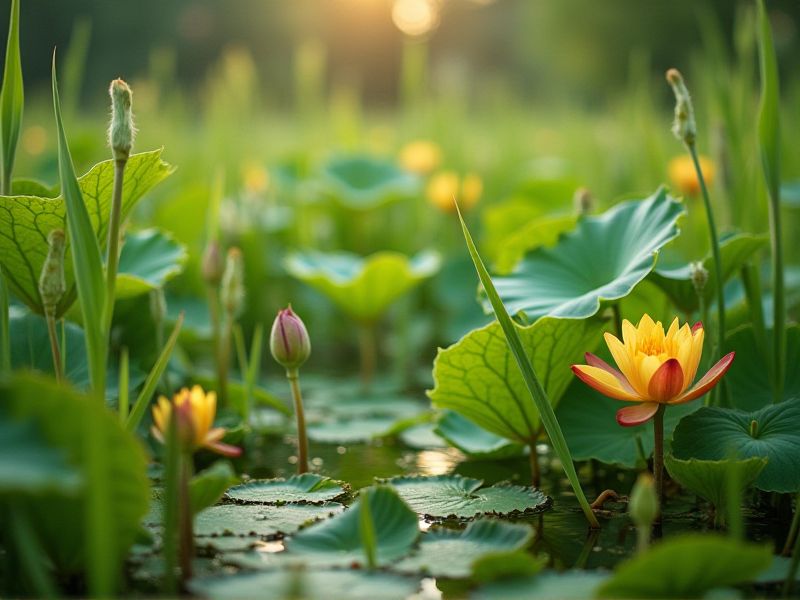
Wetland plants, such as cattails, bulrushes, and eelgrass, play a vital role in creating as well as maintaining aquatic habitats. These plants stabilize soil, preventing erosion while serving as a food source and shelter for various wildlife, including fish, amphibians, and birds. The dense root systems of wetland vegetation filter pollutants from water, improving overall ecosystem health. In addition, plants like water lilies and sedges contribute to oxygen production, enhancing water quality for the organisms that rely on these environments. Understanding the importance of wetland plants helps in conservation efforts aimed at preserving biodiversity and protecting water resources.
List of some Wetland plants that build habitat
- Cattail (Typha latifolia)
- Common Reed (Phragmites australis)
- Bulrush (Schoenoplectus spp.)
- Water Horsetail (Equisetum fluviatile)
- Pickerelweed (Pontederia cordata)
- Soft Rush (Juncus effusus)
- Marsh Marigold (Caltha palustris)
- Arrow Arum (Peltandra virginica)
- Swamp Milkweed (Asclepias incarnata)
- Giant Bur-reed (Sparganium eurycarpum)
Important things about Wetland plants that build habitat
Biodiversity Support
Wetland plants, including species like cattails, bulrushes, and sedges, play a crucial role in enhancing biodiversity by creating habitats for various wildlife. These plants stabilize soil, reducing erosion while also providing essential food and shelter for birds, amphibians, and aquatic organisms. The intricate root systems of wetland vegetation not only filter water pollutants but also improve water quality, benefiting the overall ecosystem. You can observe a thriving community of insects and microorganisms that depend on these habitats, showcasing the vital interconnections within wetland ecosystems.
Water Filtration
Wetland plants play a crucial role in water filtration and habitat creation within their ecosystems. Species such as cattails, bulrushes, and sedges are adept at removing pollutants, absorbing excess nutrients, and breaking down contaminants, thereby enhancing water quality. These plants also provide essential habitats for a diverse range of wildlife, including birds, amphibians, and aquatic species, fostering biodiversity. By establishing healthy wetland plant communities, you can contribute to improved water management and ecosystem resilience.
Erosion Control
Wetland plants such as bulrushes, cattails, and sedges play a crucial role in erosion control by stabilizing soil with their extensive root systems. These native species create habitats that support diverse wildlife, including migratory birds, amphibians, and aquatic organisms. By absorbing excess water and filtering pollutants, wetland plants enhance water quality while mitigating the effects of flooding. Incorporating these plants in your landscape can promote ecological resilience and foster a thriving ecosystem.
Nutrient Cycling
Wetland plants play a crucial role in nutrient cycling within their ecosystems, as they facilitate the uptake and transformation of organic and inorganic matter. Species such as cattails and bulrushes not only filter pollutants but also promote the retention of essential nutrients like nitrogen and phosphorus, enhancing soil fertility. These plants create habitat structures that provide shelter and breeding grounds for various aquatic and terrestrial wildlife, enriching biodiversity. By stabilizing sediment, wetland vegetation further supports the ecosystem's overall health, showcasing the interconnection between plant life and nutrient dynamics.
Carbon Storage
Wetland plants play a crucial role in carbon storage by sequestering carbon dioxide through photosynthesis, which contributes to mitigating climate change. Species like cattails, bulrushes, and sedges not only absorb carbon but also create rich habitats that support diverse ecosystems, including various wildlife and aquatic organisms. The organic matter produced by these plants accumulates in the soil, enhancing its carbon storage capacity and promoting nutrient cycling. By preserving and restoring wetland areas, you can significantly enhance local biodiversity while contributing to global carbon reduction efforts.
Wildlife Habitat
Wetland plants, such as cattails, bulrushes, and water lilies, play a crucial role in building and sustaining diverse wildlife habitats. These plants provide essential food sources and shelter for various animal species, including amphibians, birds, and aquatic insects. The dense root systems of wetland vegetation help stabilize soil, reducing erosion and improving water quality, which is vital for maintaining healthy ecosystems. By supporting biodiversity and offering critical resources, wetland plants are indispensable for the durability and functionality of these unique habitats.
Flood Mitigation
Wetland plants play a crucial role in flood mitigation by enhancing habitat and improving ecosystem resilience. Species such as cattails, bulrushes, and native sedges not only stabilize soil but also absorb excess water, reducing runoff and erosion during heavy rainfall. These plants provide vital habitat for wildlife, promoting biodiversity and balancing local ecosystems. By incorporating wetland vegetation into flood-prone areas, you can significantly improve water management and enhance the natural functionality of these environments.
Soil Stabilization
Wetland plants such as cattails, bulrushes, and pickerelweed play a crucial role in soil stabilization within their ecosystems. These plants possess extensive root systems that anchor the soil, preventing erosion and promoting sediment deposition. By creating dense root mats, they enhance soil structure and contribute to the buildup of organic matter, which improves nutrient availability for other organisms. You can support these habitats by planting native wetland vegetation in areas prone to erosion, fostering biodiversity and strengthening the ecosystem.
Pollinator Attraction
Wetland plants such as cattails, bulrushes, and marsh mallow play a crucial role in attracting pollinators while simultaneously providing essential habitat. These native species offer nectar and pollen, supporting diverse pollinator populations like bees, butterflies, and hummingbirds. By creating a rich ecosystem, these plants help maintain biodiversity, as they provide shelter for various microorganisms and wildlife, contributing to overall wetland health. You can enhance your local wetland area by incorporating more native plants, fostering a thriving environment for both pollinators and aquatic life.
Aesthetic Value
Wetland plants, such as cattails, bulrushes, and water lilies, play a crucial role in creating diverse habitats for wildlife. These plants not only provide shelter for various species, including amphibians, birds, and aquatic organisms, but also contribute to the aesthetic beauty of wetland ecosystems. The vibrant colors and textures of wetland vegetation enhance the visual landscape while supporting ecological balance by filtering water and stabilizing soil. By incorporating wetland plants into your environment, you can improve both the aesthetic appeal and the biodiversity of your natural surroundings.
